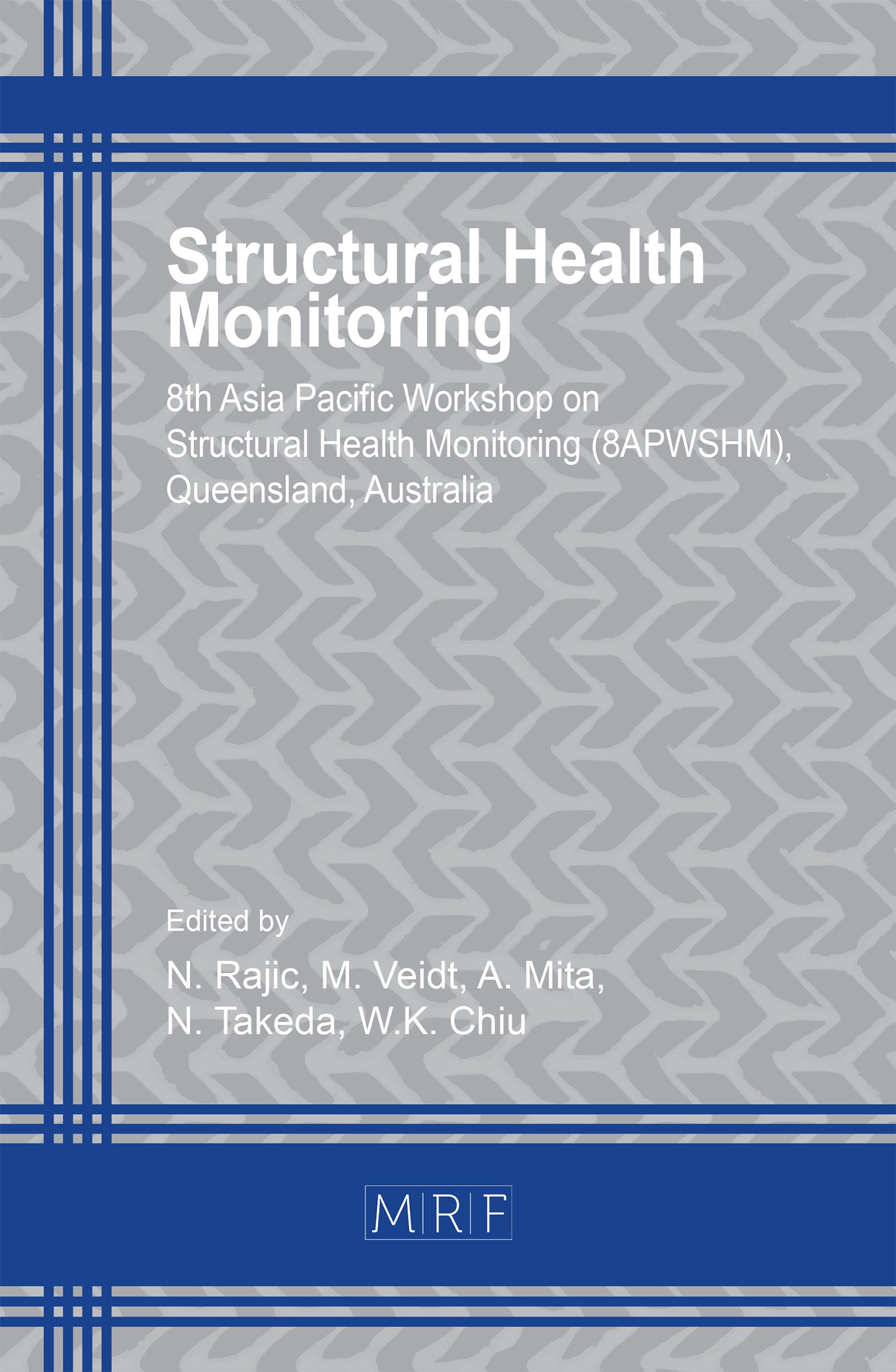Life-Cycle Monitoring of CFRP using Piezoelectric Sensors Network
Xiao Liu, Yishou Wang, Xinlin Qing
download PDFAbstract. Vacuum Assisted Resin Infusion (VARI) process is suitable for manufacturing complex large-scale composite structures and has the potential for low cost and mass production. However, the inappropriate process parameters such as incomplete resin flow and the uneven cure occurred will lead to some defects such as dry spots and delamination. In the present work, the concept of Networked Elements for Resin Visualization and Evaluation (NERVE) with the piezoelectric lead-zirconate-titanate (PZT) sensors as the base unit was used to monitor the internal state of composite struture during its life-time. The capability of PZT sensors in the NERVE to monitor two important parameters during the manufacturing process including the flow front of resin and progress of reaction (POR), was investigated. The Lamb waves generated by PZT, propagating in the mold/composite, was used to measure the parameters. The resin flow front was analyzed using optical detection at the same time. The flow front position over time and the influence of the length of sensing path covered by resin were delivered. The effects of different resin cure state on Lamb signal attenuation and energy leakage were also obtained. The change of amplitude was integrated to get the POR curves, so the resin cure state could be also monitored. After the composite was demoulded, the network was used contiously to identify the artifical damages with the fused probability-based diagnostic imaging (PDI). Experimental results indicate that the NERVE has the ability to realize the full life-cycle health monitoring of composite structures.
Keywords
Resin Infusion, Damage Identification, Piezoelectric Sensor Network, Structural Health Monitoring
Published online 2/20/2021, 10 pages
Copyright © 2021 by the author(s)
Published under license by Materials Research Forum LLC., Millersville PA, USA
Citation: Xiao Liu, Yishou Wang, Xinlin Qing, Life-Cycle Monitoring of CFRP using Piezoelectric Sensors Network, Materials Research Proceedings, Vol. 18, pp 121-130, 2021
DOI: https://doi.org/10.21741/9781644901311-15
The article was published as article 15 of the book Structural Health Monitoring
![]() Content from this work may be used under the terms of the Creative Commons Attribution 3.0 licence. Any further distribution of this work must maintain attribution to the author(s) and the title of the work, journal citation and DOI.
Content from this work may be used under the terms of the Creative Commons Attribution 3.0 licence. Any further distribution of this work must maintain attribution to the author(s) and the title of the work, journal citation and DOI.
References
[1] Minakuchi S, Takeda N, Takeda S I, et al. Life cycle monitoring of large-scale CFRP VARTM structure by fiber-optic-based distributed sensing[J]. Composites Part A: Applied Science and Manufacturing, 2011, 42(6):669-676. https://doi.org/10.1016/j.compositesa.2011.02.006
[2] Laurenzi S, Casini A, Pocci D. Design and fabrication of a helicopter unitized structure using resin transfer moulding. Composites Part A: Applied Science and Manufacturing, 2014, 67:221-232. https://doi.org/10.1016/j.compositesa.2014.09.007
[3] Konstantopoulos S, Hueber C, Antoniadis I, et al. Liquid composite molding reproducibility in real-world production of fiber reinforced polymeric composites: a review of challenges and solutions. Advanced Manufacturing: Polymer & Composites Science, 2019,5:3, 85-99. https://doi.org/10.1080/20550340.2019.1635778
[4] Park CH, Woo L. Modeling void formation and unsaturated flow in liquid composite molding processes: a survey and review. Journal of Reinforced Plastics & Composites 2011; 30(11):957–977. https://doi.org/10.1177/0731684411411338
[5] Kuentzer N, Simacek P, Advani SG, Walsh S. Correlation of void distribution to VARTM manufacturing techniques. Composites Part A: Applied Science and Manufacturing, 2007, 38(3):802–813. https://doi.org/10.1016/j.compositesa.2006.08.005
[6] Khoun L, Palardy G, Hubert P. Relation between volumetric changes of unsaturated polyester resin and surface finish quality of fiberglass/unsaturated polyester composite panels. Polymer Composites, 2011, 32(9): 1473-80. https://doi.org/10.1002/pc.21157
[7] Villière, Maxime, Guéroult, Sébastien, Sobotka V, et al. Dynamic saturation curve measurement in liquid composite molding by heat transfer analysis. Composites Part A: Applied Science and Manufacturing, 2015, 69:255-265. https://doi.org/10.1016/j.compositesa.2014.11.024
[8] Shin DD, Hahn HT. Compaction of thick composites: Simulation and experiment. Polymer Composites, 2004, 25(1): 49-59. https://doi.org/10.1002/pc.20004
[9] Wang Y, Li Y, Wu D, et al. Progress on cure monitoring for Liquid Composite Molding. Aeronautical Manufacturing Technology, 2017(19):50-59.
[10] Pavlopoulou S, Soutis C, Staszewski W J. Cure monitoring through time-frequency analysis of guided ultrasonic waves, Plastics, Rubber and Composites 41(2012)180-186. https://doi.org/10.1179/1743289811Y.0000000052
[11] Hudson T B, Grimsley B W, Yuan F G. Development of a fully automated guided wave system for in-process cure monitoring of CFRP composite laminates, Proceeding of 31st American Society for Composites Technical Conference and ASTM Committee,2016.
[12] Liu X, Li Y, Zhu J, Wang Y, Qing X. Monitoring of resin flow front and degree of cure in VARI process using multifunctional piezoelectric sensor network. Polymer Composite, accepted for publication.
[13] Predoi M V, Castaings M, Hosten B, et al. Wave propagation along transversely periodic structures[J]. Journal of the Acoustical Society of America, 2007, 121(4):1935-0. https://doi.org/10.1121/1.2534256
[14] Castaings M, Lowe M. Finite element model for waves guided along solid systems of arbitrary section coupled to infinite solid media[J]. Journal of the Acoustical Society of America, 2008, 123(2):696-0. https://doi.org/10.1121/1.2821973
[15] Qiu L, Liu M, Qing X, et al. A quantitative multidamage monitoring method for large-scale complex composite[J]. Structural Health Monitoring, 2013, 12(3):183-196. https://doi.org/10.1177/1475921713479643
[16] Wang D, Ye L, Lu Y, et al. Probability of the presence of damage estimated from an active sensor network in a composite panel of multiple stiffeners[J]. Composites ence & Technology, 2009, 69(13):2054-2063. https://doi.org/10.1016/j.compscitech.2008.11.005
[17] Zhanjun Wu, Kehai Liu, Yishou Wang, et al. Validation and evaluation of damage identification using probability-based diagnostic imaging on a stiffened composite panel[J]. Journal of Intelligent Material Systems & Structures, 2014.
[18] Liu K, Ma S, Wu Z, et al. A novel probability-based diagnostic imaging with weight compensation for damage localization using guided waves[J]. Structural Health Monitoring, 2016, 15(2):162-173. https://doi.org/10.1177/1475921715627491
[19] Qing X, Liu X, Zhu J, Wang Y. In-situ monitoring of Liquid Composite Molding process using piezoelectric sensor network[J]. Structural Health Monitoring, accepted for publication.
[20] Qing X, Beard S, Kumar K, et al. Advances in the development of built-in diagnostic system for filament wound composite structures. Composites Science & Technology 2006; 66(11-12):1694–1702. https://doi.org/10.1016/j.compscitech.2005.11.007































